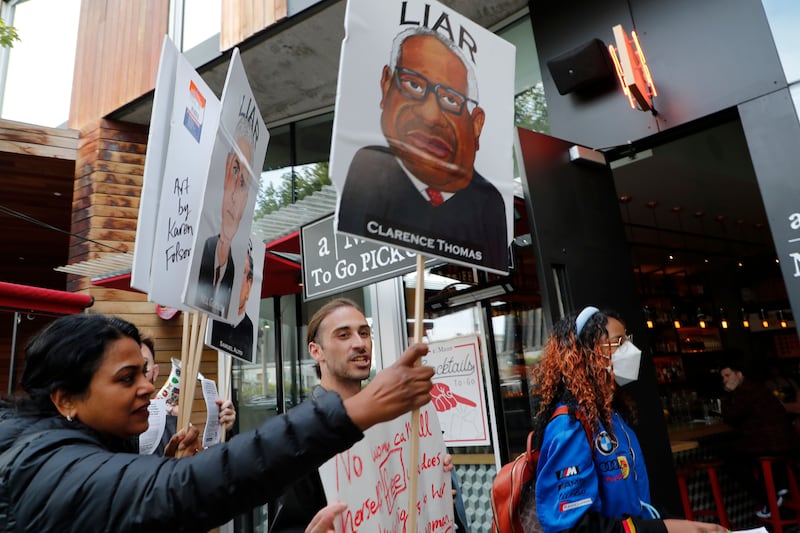In the big US pharmacy chains, staff are beginning to ration access to emergency contraception.
Following last week’s supreme court decision eliminating a 50-year-old federal constitutional right to abortion, there has been a spike in demand from women fearful about what the future might bring.
Outlets such as CVS and Walmart have introduced limits on the quantity of emergency contraception products that can be purchased.
The supreme court ruling definitively ended the constitutional right to abortion introduced on foot of the landmark Roe v Wade ruling by the same body in 1973.
READ MORE
However, there is no certainty on what it all will mean. And comments by conservative justice Clarence Thomas that the court’s legal reasoning on abortion should see it look again at other social rights, such as contraception and same-sex marriage, has heightened alarm among many.
Earlier this week, US vice-president Kamala Harris warned that the court, which has a conservative supermajority, would not stop at eliminating the constitutional right to abortion. She suggested that Thomas had “just said the quiet part out loud”.
The majority in the court argued that its abortion ruling would not jeopardise contraception or same-sex marriage. However, some liberals fear that Thomas was effectively inviting politicians in conservative states to pass laws restricting such rights, leading to an inevitable legal challenge that would end up before him and his colleagues in the supreme court.
The supreme court did not outlaw abortion last week. Rather it sent the whole issue back to politicians, initially in the different states, and perhaps at a later date centrally in Washington, to determine what should be done now about abortion services.
It was this uncertainty about the implications of the ruling, including fears that some states could ban morning-after and abortion pills, that has seen some women move to try to stock up in advance, leading to a run on supplies in some areas.
What is certain is that for the present there will be a patchwork of rules in place regarding abortion across the US.
Already since last week, about 10 states have moved to ban or restrict abortion. These had what are known as “trigger laws” in place to be implemented quickly after any striking down of the federal constitutional right to abortion.
However, in some places, courts have intervened to block temporarily these measures pending full hearings.
Other states are re-invoking dormant legislation outlawing abortion which pre-dated the 1973 Roe v Wade ruling.
The pro-choice Guttmacher Institute has forecast that ultimately 26 states are certain or likely to ban abortion.
Politicians in states such as New York, Illinois and California have insisted they will provide a sanctuary for women from other areas seeking abortion. However, providers have warned of pressure on services from an influx of women travelling from other locations.
In the different states the language in the new legislation defining what constitutes an abortion can vary — leading to some concerns that, intentionally or otherwise, some forms of contraception could be caught up in the net.
One hospital group in Missouri this week stopped offering emergency contraception as it was concerned that “ambiguous” provisions in the state’s legislation could result in clinicians facing prosecution.
In Mississippi, one of the people who drafted the abortion law which directly led to the supreme court ruling last week said “chemical abortion” was likely to be the new frontline in the war between anti-abortion and pro-choice activists.

Jameson Taylor, president of the Center for Political Renewal, told The Irish Times that the supreme court in what is now known as the Dobbs case (the court ruled on the case of Dobbs v Jackson Women’s Health Organization) last week “did not settle anything”. But he said it would be better to have dialogue and debate at local level in states on the complex issue of abortion.
He forecast there would be “a lot of inconsistencies” as states made rules for themselves.
“When it comes to states regulating chemical abortion, which is going to be basically the new front of the abortion wars in the United States, that is going to be a very complex situation as we are going to run into inter-state commerce [laws] and significant constitutional issues, in terms of states trying to regulate commercial activity between a consumer in one state and service being available in another.”
Mr Taylor forecast that the Biden administration would “act aggressively to blur the lines between traditional contraception and abortifacients and chemical abortions”.
This is already an area of confusion and debate in the US due, in part, to a label applied by the federal regulator, the Food and Drug Administration, to the emergency contraceptive pill since 2006. This says it blocks release of eggs before fertilisation but also maintains the medication can prevent fertilised eggs from implanting.
However, this is in dispute.
The American College of Obstetricians and Gynecologists has maintained a review of the evidence suggests that “emergency contraception is unlikely to prevent implantation of a fertilised egg”.
Some conservatives have used the label to argue that such products are “abortifacients”.
The net effect of the supreme court ruling and local laws being introduced in some regions is that the United States could be effectively split in two in relation to abortion services. In one half, existing abortion rights would remain largely intact but in the other terminations would either be banned or restricted.
But for some campaigners and politicians, this would not go far enough.
The speaker of the House of Representatives Nancy Pelosi last week said Republicans were plotting to put in place a nationwide abortion ban.
Such warnings about what Republicans would do if they regained control of congress may be aimed in part at encouraging Democrats to get out and vote in the forthcoming mid-term elections.
Joe Biden as president would never sign such a national ban into law. However, after 2024 a future president — perhaps Mike Pence? — could do so.
Pence last week said: “Having been given this second chance for life, we must not rest and must not relent until the sanctity of life is restored to the centre of American law in every state in the land.”
Biden has condemned the supreme court decision. But the president has come under pressure from Democrats to do more to assist women seeking abortion services.
Liberals have argued, for example, he could establish abortion clinics on federal lands in states where the procedure is banned. However, so far, the administration has been wary. The White House warned this could have “dangerous ramifications” and could put women and providers at risk of potential prosecution.
The president has promised to fight for the rights of women to access abortion pills by post and to travel for terminations. His administration issued new guidance to protect the privacy of patients’ data generated, for example, by period trackers and other health information apps on their smartphones.
Anyone who lived through the convulsions in Ireland in the late 1980s and early 1990s over abortion would be familiar with some of the arguments under way in the US — for example, over whether information on termination services out of state should be permitted and the right to travel allowed.
Last weekend, the Republican governor of South Dakota promised to ban mail-order abortion pills. Kristi Noem suggested doctors rather than patients could face prosecution.
Ireland was also raised by US secretary of health Xavier Becerra this week. He maintained abortion rights in the US were being stripped away when things were going in the opposite direction elsewhere. “Look at Ireland,” he said.












